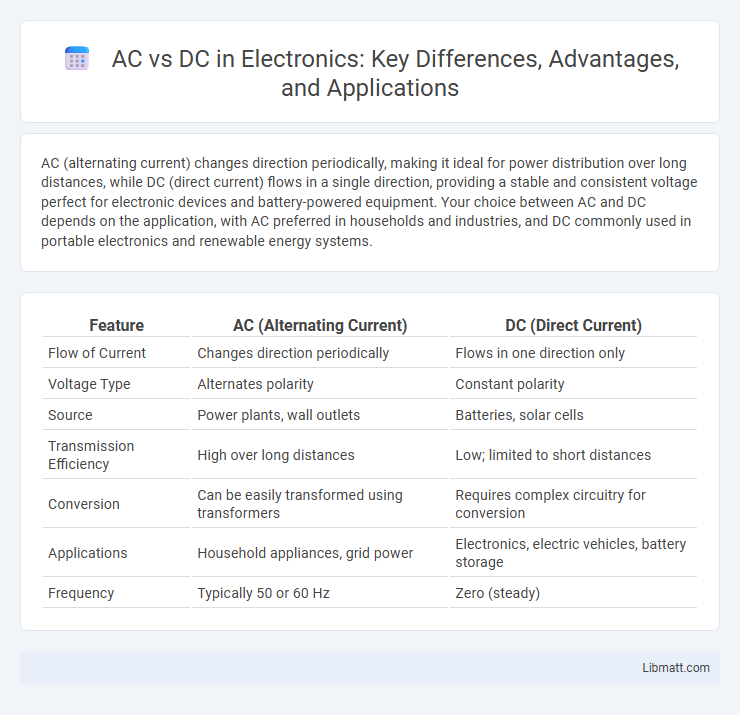AC (alternating current) changes direction periodically, making it ideal for power distribution over long distances, while DC (direct current) flows in a single direction, providing a stable and consistent voltage perfect for electronic devices and battery-powered equipment. Your choice between AC and DC depends on the application, with AC preferred in households and industries, and DC commonly used in portable electronics and renewable energy systems.
Table of Comparison
| Feature | AC (Alternating Current) | DC (Direct Current) |
|---|---|---|
| Flow of Current | Changes direction periodically | Flows in one direction only |
| Voltage Type | Alternates polarity | Constant polarity |
| Source | Power plants, wall outlets | Batteries, solar cells |
| Transmission Efficiency | High over long distances | Low; limited to short distances |
| Conversion | Can be easily transformed using transformers | Requires complex circuitry for conversion |
| Applications | Household appliances, grid power | Electronics, electric vehicles, battery storage |
| Frequency | Typically 50 or 60 Hz | Zero (steady) |
Understanding AC and DC: Basic Definitions
Alternating Current (AC) is an electric current that periodically reverses direction, commonly used for power distribution in homes and industries. Direct Current (DC) flows continuously in one direction, typically found in batteries, electronic devices, and solar power systems. Understanding the fundamental differences between AC and DC helps you select the appropriate current type for specific electrical applications.
Historical Development of AC and DC
The historical development of AC and DC power reflects key milestones, with Thomas Edison pioneering direct current (DC) systems in the late 19th century for early electric lighting and power distribution. Nikola Tesla and George Westinghouse advanced alternating current (AC) technology, enabling efficient long-distance transmission and widespread adoption by the 1890s. The "War of Currents" between Edison and Tesla highlighted the strengths of AC in scalability and transmission, ultimately establishing AC as the dominant standard for power grids worldwide.
How AC Works: Principles and Applications
Alternating Current (AC) works by periodically reversing the direction of electron flow, creating a sinusoidal waveform that enables efficient transmission of electrical power over long distances. Its ability to easily transform voltages using transformers makes AC ideal for use in power grids, household wiring, and industrial machinery. Applications of AC include powering homes, operating electric motors, and enabling renewable energy systems, leveraging its versatility and efficiency in varied electrical infrastructures.
How DC Works: Principles and Applications
Direct current (DC) flows consistently in a single direction, powered by a constant voltage source such as batteries or solar cells. Its principles rely on the steady movement of electrons through conductive materials, making it ideal for low-voltage applications in electronics, electric vehicles, and telecommunications. DC power systems excel in energy storage and conversion, supporting devices that require stable and uninterrupted electricity.
Key Differences Between AC and DC
AC (Alternating Current) reverses direction periodically and is widely used in household power distribution, while DC (Direct Current) flows consistently in one direction, commonly powering batteries and electronic devices. The frequency of AC varies by region, typically 50 or 60 Hz, whereas DC maintains a steady voltage without fluctuation. Understanding these key differences helps you choose the appropriate current type for specific applications, ensuring optimal electrical performance and efficiency.
Advantages of AC Power
AC power offers significant advantages including efficient transmission over long distances due to its ability to easily transform voltages using transformers, resulting in reduced energy losses. The widespread use of AC in the power grid supports compatibility with most household appliances and industrial machinery. Furthermore, AC systems facilitate simpler and cost-effective generation, distribution, and metering compared to DC power.
Advantages of DC Power
DC power offers greater efficiency for electronic devices and battery-powered systems due to its consistent voltage supply. It enables easier energy storage and seamless integration with renewable energy sources like solar panels and fuel cells. DC circuits also reduce power losses over long distances in low-voltage applications, improving overall system performance.
Common Uses of AC vs DC in Everyday Life
Alternating current (AC) powers most household appliances, lighting systems, and large-scale electrical grids due to its efficient long-distance transmission. Direct current (DC) is prevalent in battery-operated devices such as smartphones, laptops, and electric vehicles, providing stable and consistent voltage. The widespread use of AC for residential and commercial electricity contrasts with DC's dominance in portable electronics and renewable energy storage systems.
Future Trends: AC vs DC in Modern Technology
Modern technology increasingly favors DC power for its efficiency in renewable energy systems, electric vehicles, and data centers, where direct current reduces energy loss during transmission and conversion. AC remains dominant in grid distribution due to its ability to easily transform voltage levels for long-distance power delivery. Your choice between AC and DC will depend on specific technology applications, with DC gaining momentum in decentralized and sustainable energy solutions.
Choosing Between AC and DC: Factors to Consider
Choosing between AC and DC power depends on factors such as distance, efficiency, and application type; AC is preferred for long-distance transmission due to lower energy losses, while DC is favored for electronic devices requiring stable and consistent voltage. Consider the complexity and cost of infrastructure, as AC systems often involve transformers and can easily change voltage levels, whereas DC systems typically require converters. Safety and compatibility with existing equipment also influence the decision, with AC being more common in household and industrial environments and DC essential for batteries, solar power, and electric vehicles.
AC vs DC Infographic

 libmatt.com
libmatt.com